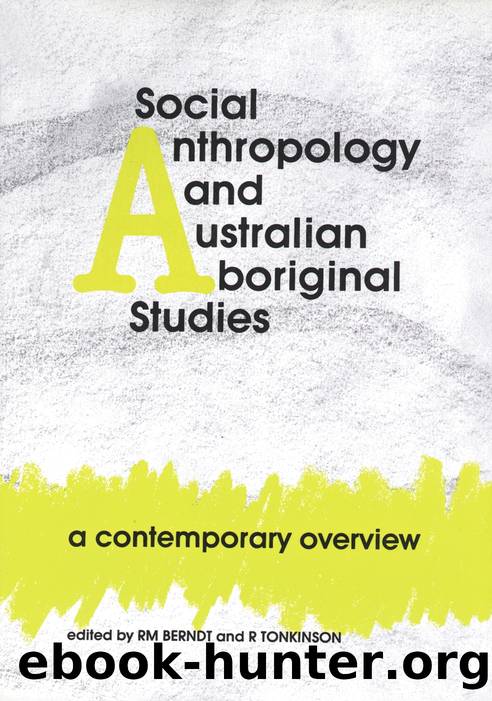Social Anthropology and Australian Aboriginal Studies by Ronald M. Berndt

Author:Ronald M. Berndt
Language: eng
Format: epub
Publisher: Aboriginal Studies Press
Published: 2011-06-16T16:00:00+00:00
Thomson was accompanied by naturalists on his desert trips and, although no major academic work came of these, his 1975 book is interspersed with information on desert ecology, material culture and subsistence activities.
Norman Tindale, who originally trained and worked as an entomologist, was Curator of Ethnology at the South Australian Museum from 1927 until 1965. He did major anthropological fieldwork on Groote Eylandt (Tindale 1925, 1926, 1959), at Princess Charlotte Bay (Hale and Tindale 1933, 1934), and in central Australia and northern South Australia (see for example, Tindale 1972, 1977, 1981). Tindale’s earliest ethnographic works, for example his Princess Charlotte Bay publications, were traditional in their coverage of most aspects of Aboriginal life, although they were probably more comprehensive on material culture and food procuring activities than most work of the time. In 1936-37, while a Carnegie Fellow, Tindale met Carl Sauer at Berkeley. Sauer was a major influence on American ecological anthropology and geography; from this time on, Tindale’s anthropological work takes on a distinctly ecological orientation and it shares important assumptions with the work of archaeologists described above (see Tindale 1959, Tindale and Cleland 1954, Cleland 1966).4 The multidisciplinary nature of many of his fieldtrips and his interest in natural history also helped incline him in this direction. If one examines his whole work, the importance of the ecological approach and the hypotheses he generated with it become apparent. This fact has become overshadowed by Tindale’s reputation concerning his work on ‘tribes’ in Australia (although the latter is also largely a result of his ecological perspective; see also the work of Birdsell on this). Here I want to review briefly his major works published since 1970.
Tindale’s 1972 work is a detailed description of the Pitjantjatjara of northern South Australia, Tindale (1981) compares desert dwelling Aborigines with the southern coastal peoples. His massive work on Aboriginal Tribes of Australia (1974) contains a great deal of summary information on the ecology and subsistence activities of Aborigines over the whole continent. In his 1972 paper, Tindale gives a description of Pitjantjatjara movements and of subsistence activities, along with a detailed outline of the region’s climate, topography and vegetation. The necessity for the latter is seen in that Tindale posits largely ecological factors for things such as territorial limits and the determination of camp site locations. Territorial limits are‘usually...at places least likely to sustain life for long periods of time’ (Tindale 1972, 236). The major factors in camp site location are, according to Tindale: water, firewood, ability to see the approach of strangers, ground texture, presence or absence on the ground of prickly plant species, wind obstruction, distance to game and distance women have to travel to gather vegetable food (1972, 244-45). His discussion of Pitjantjatjara social organisation and ceremony is descriptive and not linked directly to environmental factors.
However, this is not the case in his 1981 paper. Here Tindale often argues for a relationship between sociocultural elements and ecological variables. Generally though, unlike Gould, Tindale only goes so far as to
Download
This site does not store any files on its server. We only index and link to content provided by other sites. Please contact the content providers to delete copyright contents if any and email us, we'll remove relevant links or contents immediately.
Investing For Dummies by Eric Tyson(2920)
The Book on Rental Property Investing by Turner Brandon(1792)
The Book On Tax Strategies for the Savvy Real Estate Investor by Amanda Han & Matthew MacFarland(1698)
Every Landlord's Legal Guide by Janet Portman & Stewart Marcia & Ralph Warner(1648)
The Thibaults by Roger Martin Du Gard(1583)
Personal Finance For Dummies (9th Edition) by Eric Tyson(1544)
Real Estate Licensing Exams by Raymond D. Modglin(1527)
Investing 101 by Michele Cagan(1386)
The Plaza by Julie Satow(1360)
Bill Bryson by At Home(1339)
Now I Sit Me Down by Witold Rybczynski(1307)
Irrational Exuberance by Shiller Robert J. J(1280)
The Real Book of Real Estate by Robert T. Kiyosaki(1263)
Real Estate License Exams For Dummies by Yoegel John A(1243)
7 Steps to Wealth by John L. Fitzgerald(1226)
Real Estate Math Demystified by Steven P. Mooney(1208)
Mortgages 101 by David Reed(1193)
The Business of Flipping Homes by William Bronchick(1185)
SAP Flexible Real Estate Management by Jayant Daithankar(1183)
